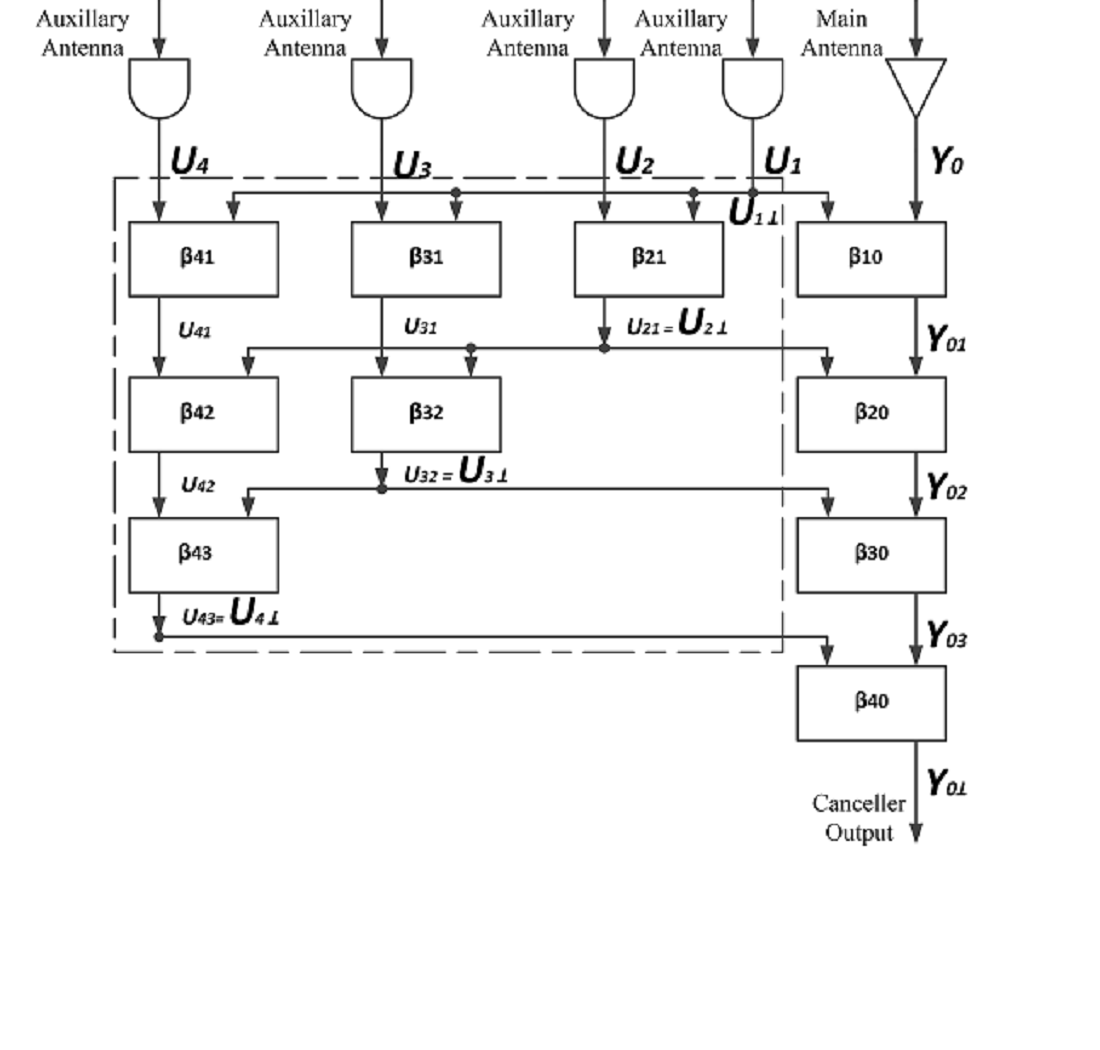Development of an adaptive multi-channel correlation sidelobe canceller for active noise interference based on the Gram-Schmidt orthogonalization procedure
DOI:
https://doi.org/10.15587/1729-4061.2024.319253Keywords:
multi-channel sidelobe canceller, sidelobe canceller, decorrelation, compensation channel, Gram-Schmidt procedure, Gram-Schmidt orthogonalization procedureAbstract
The object of the study is the process of adapting a multi-channel correlation sidelobe canceller to work in conditions of radio-electronic countermeasures based on the Gram-Schmidt orthogonalization procedure. The proposed approach allows developing a fast, recursive algorithm for searching for optimal values of weight coefficients. Such an algorithm will ensure fast adaptation of the sidelobe canceller to a complex interference-target situation, which can change rapidly. The obtained result of the coefficient of suppression of active noise interference in a constant value approaches the optimal value determined by the Wiener-Hopf equation, which indicates the effectiveness of the proposed approach.
By using the Gram-Schmidt orthogonalization procedure, it was possible to obtain high stability of the procedures for calculating the optimal values of weight coefficients, in contrast to other considered approaches. The proposed approach can be practically implemented in existing radar systems for suppressing active noise interference.
During the study, it was found that the adaptive multi-channel correlation sidelobe canceller in a steady-state mode works similarly to adaptive phased antenna arrays - it has the same efficiency in spatial signal selection and in compensation of active noise interference.
When suppressing four active noise interference, the suppression coefficient is –23.35 dB. With an increase in the number of interferences at the input of the four-channel sidelobe canceller, the suppression level deteriorates rapidly. With five, six, seven, eight interferences – –22.90 dB, –21.54 dB, –20 dB, –17.02 dB, respectively. Such changes are due to the number of active interferences, which is greater than the number of compensation channels
References
- Riabukha, V. P. (2016). Adaptive radar noise jamming protection systems. 1. Correlation self-compensators based on stochastic gradient algorithms of adaptation. Applied Radio Electronics, 15 (1), 11–25. Available at: http://openarchive.nure.ua/handle/document/12103
- Pliushch, O., Toliupa, S., Vyshnivskyi, V., Rybydajlo, A. (2020). Studying of Initial Weight Vector Selection Impact on Transient Performance of Coherent Sidelobe Cancellation System with Gradient Adaptation Algorithm. 2020 IEEE International Conference on Problems of Infocommunications. Science and Technology (PIC S&T), 343–347. https://doi.org/10.1109/picst51311.2020.9467905
- Yang, W.-Y., Park, M.-K., Hong, S.-W., Kim, C.-H. (2018). Analysis of Adaptive Side-Lobe Canceller Algorithm for Fully Digital Active Array Radar. The Journal of Korean Institute of Electromagnetic Engineering and Science, 29 (5), 375–382. https://doi.org/10.5515/kjkiees.2018.29.5.375
- Hong, T. (2021). Design of an Adaptive Sidelobe Cancellation Algorithm for Radar. Journal of Physics: Conference Series, 1754 (1), 012217. https://doi.org/10.1088/1742-6596/1754/1/012217
- Zhao, X., Wang, D., Liu, J. (2023). Analysis and research of an adaptive side-lobe cancellation performance improvement method. 2023 IEEE 7th Information Technology and Mechatronics Engineering Conference (ITOEC), 1642–1646. https://doi.org/10.1109/itoec57671.2023.10291884
- Shin, H. (2017). The digitalization of analog sidelobe canceller by oridinary differential equations. 2017 IEEE Radar Conference (RadarConf), 0190–0194. https://doi.org/10.1109/radar.2017.7944195
- Shin, H. (2018). The mitigation of multiple jammers using a sidelobe canceller designed with independently configured loops. 2018 IEEE Radar Conference (RadarConf18), 0969–0974. https://doi.org/10.1109/radar.2018.8378692
- Monzingo, R. A., Haupt, R. L., Miller, T. W. (2011). Introduction to Adaptive Arrays. Institution of Engineering and Technology. https://doi.org/10.1049/sbew046e
- Shyrman, Ya. D., Manzhos, V. M. (2008). Teoriya i tekhnyka obrobky radiolokatsiynoi informatsiyi na foni pereshkod. Kharkiv, 268.
- Hryzo, A., Nevmerzhitsky, I., Dodukh, O., Sapehin, Y. (2021). Suggestions for modernization of protection device of radar П-18 Malakhite from active noise interference. Science and Technology of the Air Force of Ukraine, 2 (43), 104–110. https://doi.org/10.30748/nitps.2021.43.14
- Pliushch, O. (2019). Gradient Signal Processing Algorithm for Adaptive Antenna Arrays Obviating Reference Signal Presence. 2019 IEEE International Scientific-Practical Conference Problems of Infocommunications, Science and Technology (PIC S&T), 635–638. https://doi.org/10.1109/picst47496.2019.9061536
- Chmelov, V., Zhuk, S., Onysko, A., Tereshchenko, O. (2022). Structural-parametric adaptation of the active noise interference autocompensator implementing the Gram-Schmidt orthogonalization procedure. 2022 IEEE 16th International Conference on Advanced Trends in Radioelectronics, Telecommunications and Computer Engineering (TCSET), 733–736. https://doi.org/10.1109/tcset55632.2022.9767061
- Zhuk, S. Ya., Semibalamut, K. M., Litvincev, S. N. (2017). Mnogostupenchataya adaptivnaya kompensaciya aktivnyh shumovyh pomekh s blochnoy ortogonalizaciey signalov kompensacionnyh kanalov. Visti vyshchykh uchbovykh zakladiv. Radioelektronika, 60 (6), 311–326. https://doi.org/10.20535/s0021347017060012

Downloads
Published
How to Cite
Issue
Section
License
Copyright (c) 2024 Serhii Zhuk, Viacheslav Chmelov, Oleksandr Tereshchenko

This work is licensed under a Creative Commons Attribution 4.0 International License.
The consolidation and conditions for the transfer of copyright (identification of authorship) is carried out in the License Agreement. In particular, the authors reserve the right to the authorship of their manuscript and transfer the first publication of this work to the journal under the terms of the Creative Commons CC BY license. At the same time, they have the right to conclude on their own additional agreements concerning the non-exclusive distribution of the work in the form in which it was published by this journal, but provided that the link to the first publication of the article in this journal is preserved.
A license agreement is a document in which the author warrants that he/she owns all copyright for the work (manuscript, article, etc.).
The authors, signing the License Agreement with TECHNOLOGY CENTER PC, have all rights to the further use of their work, provided that they link to our edition in which the work was published.
According to the terms of the License Agreement, the Publisher TECHNOLOGY CENTER PC does not take away your copyrights and receives permission from the authors to use and dissemination of the publication through the world's scientific resources (own electronic resources, scientometric databases, repositories, libraries, etc.).
In the absence of a signed License Agreement or in the absence of this agreement of identifiers allowing to identify the identity of the author, the editors have no right to work with the manuscript.
It is important to remember that there is another type of agreement between authors and publishers – when copyright is transferred from the authors to the publisher. In this case, the authors lose ownership of their work and may not use it in any way.









